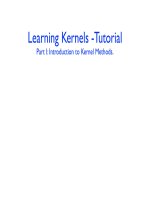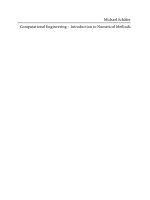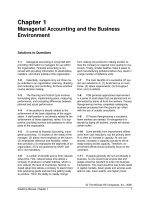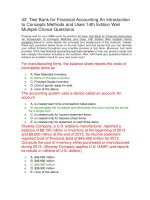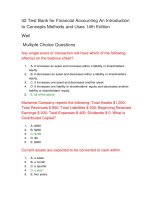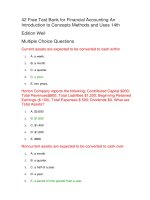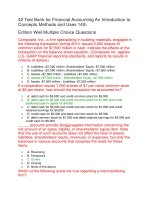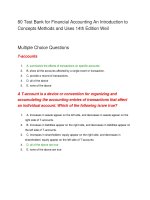Managerial accounting and introduction to concepts methods and user 11e by maher chapter 05
Bạn đang xem bản rút gọn của tài liệu. Xem và tải ngay bản đầy đủ của tài liệu tại đây (401.76 KB, 28 trang )
CHAPTER 5
Cost Drivers and
Cost Behavior
PowerPoint Presentation by
LuAnn Bean
Professor of Accounting
Florida Institute of Technology
© 2012 Cengage Learning. All Rights Reserved. May
not be copied, scanned, or duplicated, in whole or in
part, except for use as permitted in a license
distributed with a certain product or service or
otherwise on a password-protected website for
classroom use.
Managerial Accounting 11E
Maher/Stickney/Weil
1
☼
CHAPTER GOAL
☼
This chapter discusses classifying costs and
methods for estimating cost behavior.
Fixed costs
Variable costs
All managerial decisions deal with choices
among different activity levels. Managers must
estimate which costs will vary with the activity
and by how much.
2
LO 1
VARIABLE
VARIABLE COSTS:
COSTS: Definition
Definition
Are costs that change in total as
the level of activity changes.
FIXED
FIXED COSTS:
COSTS: Definition
Definition
Are costs that do not change in total
with changes in activity levels.
3
LO 1
RELEVANT
RELEVANT RANGE:
RANGE: Definition
Definition
Is the range of activity over
which the firm expects a set of
cost behaviors to be consistent.
4
LO 1
Estimates
Estimates
of
ofvariable
variable
and
andfixed
fixed
costs
costsapply
apply
only
onlyififlevel
level
of
ofactivity
activity
lies
lieswithin
within
relevant
relevant
range.
range.
EXHIBIT 5.1
5
LO 2
FIXED COSTS
Fixed (capacity) costs are divided between
Committed costs
Capacity costs that will continue to exist even if
operations are temporarily reduced
Discretionary (programmed or managed) costs
Need not be incurred in the short run to operate the
business
6
LO 3
VARIABLE
VARIABLE and
and FIXED
FIXED COSTS:
COSTS:
A
A Reminder
Reminder
Variable costs change with the
volume of activity.
Fixed costs remain constant over
the relevant range of activity.
7
LO 3
CURVILINEAR
CURVILINEAR VARIABLE
VARIABLE
COSTS:
COSTS: Definition
Definition
Are costs that vary with the
volume of activity but not in
constant proportion.
8
LO 3
What is an example of
a curvilinear cost?
Costs become curvilinear when
volume discounts are offered.
9
LO 3
Volume
Volume
discounts.
discounts.
EXHIBIT 5.5
10
LO 3
Production
Productiontime
time
decreases
decreasesas
as
volume
volume
increases
increasesdue
duetoto
learning
learningfrom
from
experience.
experience.
EXHIBIT 5.6 A
11
LO 3
Total
Totallabor
labor
time
timeand
andcost
cost
will
willdecrease
decrease
with
withincreases
increasesinin
volume.
volume.
Time
Cost
EXHIBIT 5.6 B & C
12
LO 3
SEMIVARIABLE
SEMIVARIABLE COSTS:
COSTS:
Definition
Definition
Are costs that have both fixed and
variable components. Also called
Mixed Costs.
13
LO 3
Semifixed
Semivariable
Semifixed
Semifixed
costs
costschange
change
because
becauseof
of
changes
changesinin
long-term
long-term
assets;
assets;
semivariable
semivariable
costs
costsdo
donot.
not.
EXHIBIT 5.7
14
LO 3
SIMPLIFYING COST ANALYSES
Some
Some costs
costs do
do not
not vary
vary in
in the
the short
short run
run
over
over the
the relevant
relevant range
range (fixed
(fixed costs).
costs).
Some
Some vary
vary with
with volume
volume (variable
(variable
costs).
costs). Others
Others are
are neither
neither completely
completely
fixed
fixed or
or variable.
variable.
Decision
Decision makers
makers can
can simplify
simplify these
these
variations
variations by
by treating
treating costs
costs as
as either
either
fixed
fixed or
or variable.
variable.
15
LO 4
EXERCISE
EXERCISE 33
Name three methods of cost estimation.
Statistical regression, Account analysis, and
Engineering estimation
Press “Enter” or click left mouse button for answer.
16
LO 5
ANALYZING HISTORICAL COSTS
Two steps to analyze historical cost data
Make an estimate of the past relation
Update for current, future periods
Adjust costs for inflation and other changes
17
LO 5
TOTAL COST EQUATION
Total costs =
Fixed costs + (Variable costs × Activity)
Independent Variables
18
LO 5
ANALYZING COSTS
Steps in analyzing costs are:
Review alternative cost drivers
(independent variables)
Plot the data
Examine the data and method of
accumulation
19
LO 6
R
MULTIPLE
MULTIPLE REGRESSION:
REGRESSION:
Definition
Definition
Has more than one
independent variable.
20
LO 6
DATA PROBLEMS
Regardless of method used, results will only be
as good as the quality of the data used.
Problems include
Missing data
Outliers
Allocated and discretionary costs
Inflation
Mismatched time periods
Trade-offs in choosing time period
21
LO 7
Every
Every
method
methodof
of
cost
cost
estimation
estimation
has
hasstrengths
strengths
and
and
weaknesses.
weaknesses.
EXHIBIT 5.12
22
LO 7
COMMON SIMPLIFICATIONS
In general, more sophisticated methods provide
more accurate cost estimates than simpler
ones. Methods of simplification are
Using only one cost driver
Assuming cost behavior patterns are linear within the
relevant range
Assume cost decreases are not “sticky”
23
LO 8
DERIVING LEARNING
CURVES
Mathematically, the learning curve effect can be
expressed by the equation: Y=aX b, where
Y = average number of labor hours required per unit
for X units
a = number of labor hours required for the first unit
X = cumulative number of units produced
b = index of learning, equal to the log of the learning
rate divided by the log of 2.
24
LO 9
STANDARD ERRORS OF THE
COEFFICIENTS
The standard errors of the coefficients give an
idea of the confidence we can have in the fixed and
variable cost coefficients.
The smaller the standard error relative to its
coefficient, the more precise the estimate.
Such computational precision does not necessarily
indicate that the estimating procedure is theoretically
correct, however.
25
